Animation Display: Interior Panoramic View of the HP 200C


 |
Bill Hewlett 200A Oscillator Prototype as shown in the MEASURE "Wrapping it up" issue Courtesy of Hewlett Packard Company |
At the origin of the story is this audio oscillator built by Bill Hewlett for his Stanford University thesis project in 1938.
It is a resistance tuned oscillator covering from 35 cps (frequency unit was the cycle at this time) to 35,000 cps in 3 ranges. The major problem with such a resistor / capacitor tuned Bridge is to obtain a constant level output over a full decade frequency range. Bill Hewlett solved the problem by inserting a non-linear element in the feedback loop of the oscillator. This element controls the amount of feedback in accordance with the amplitude of oscillation and consequently maintains the proper operating point in the system. And what makes the idea a genius one is that the non-linear element is nothing else than a simple 3 Watts light bulb.
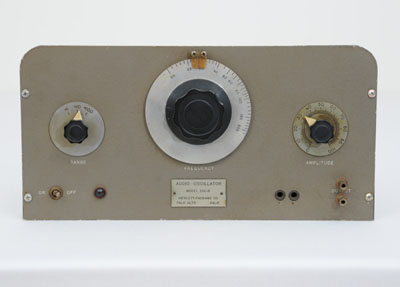 |
The HP 200B first HP Product Oldest Showpiece of the Collection |
Bill's prototype became the HP company's first product the HP 200A.
As shown in the wiring diagram below, two options with different frequency ranges were available: the 200A and 200B. A small modification of 6 resistors values resulted in different frequency ranges 35 to 35,000 cps for the 200A and 20 to 20,000 cps for the 200B.
All other specifications are common for the two units. A two-stage power amplifier with transformer-coupled output delivers 1 Watt into a 500 ohm resistance load. The output voltage is controlled ahead of the output amplifier from a front panel level control. The total harmonic distortion is lower than 0.5 %.
The HP 200B with rounded corners shown in this photo was hand built, probably in the second garage ( 481 Page Mill Road ) in 1940, and may have been handled by Bill and Dave themselves. It is so old, they do not even have a HP company logo yet. Units with this particular case style are very rare today.
| From original Instruction Notice - october 1943 - Owned by the HP Memory Project |
 |
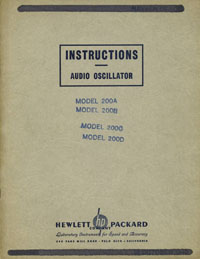 |
Cover of the Original Instruction Manual |
Click on picture or link below for a PDF (2.5 Mb) of the original instruction manual published in 1943. The manual include schematics, parts list, and chassis layout of the four different models produced by HP in 1943.
Instruction Manual for Audio Oscillators HP Model 200A, 200B, 200C and 200D .
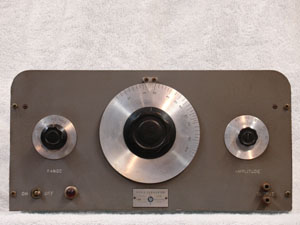 |
The HP 200B first HP Product Oldest Showpiece of the Kenneth Kuhn Collection Courtesy of Professor Kenneth Kuhn |
The HP 200B with rounded corners shown in this photo comes from the Kenneth Kuhn collection. This unit was manufactured in 1941, just after the introduction of the first HP logo, probably at the Polly and Jake's location and may also have been handled by Bill and Dave themselves.
Professor Kenneth Kuhn of the University of Alabama Birmingham is the owner and curator of one of the world's largest collections of HP original early instruments. Almost every instrument produced by Hewlett Packard during the first 20 years can be seen on his Web Site. Ken's site is also a huge source of information on the HP history.
 |
HP 200C One of the oldest showpieces of the collection |
Starting from the innovative concept of the 200A oscillator, many instruments have been built to fill in many gaps in the electronic industry of the 40s and 50s. New options added to the original circuit basis, have generated a complete signal sources product line to solve different measurements needs.
The first evolution was just an extension of the frequency range covered by the instrument. The 200C extended the first range down to 20 Hertz and added a fourth range to cover up to 200 kHz.
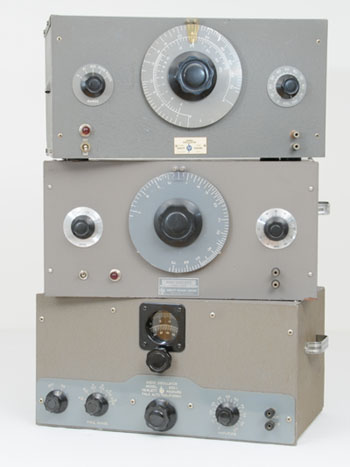 |
Three Members of the 1945, HP Model 200 Audio Oscillator family
From Top to Bottom: HP 202D, HP 200D, HP 200i |
The 202D shown on the right picture (top of the pile,) lowers the first frequency range of the Model 200 family down to 2 Hz .
The 200D (middle) covered from 7 Hz to 70 khz in four overlapping ranges.
The 200i (bottom) covered from 6 Hz to 6300 Hz in six bands.
The dial of all these instruments is calibrated directly in cycles for the lowest range. A switch selects the range and indicates the power multiplying factor. The dial calibration of Models 200A, 200B and 200C covers approximately 180 degrees, with an equivalent scale length of about 60 inches.
Under normal conditions the frequency drift is less than +/- 2 % including initial warm-up. No zero setting is necessary on these oscillators.
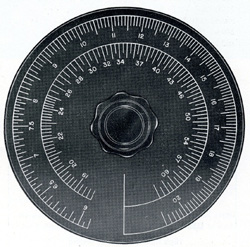 |
The HP 200i tuning dial as shown in the 1945 catalog No 18A Oldest catalog in the collection |
The front cover title of our oldest catalog No 18A dated 1945 is "LABORATORY INSTRUMENTS for Speed and Accuracy.
Accuracy was already the main guideline for new product development at HP.
Here is a picture of the 200i tuning dial as shown on page 7 of the 1945 catalog with the following comment:
"Main tuning dial of the 200i, which is an oscillator of the band-spead type, intended for comparison work. The dial is calibrated over approximately 300° with effective scale length about 90" and range of 6 cps to 6 Kc. Each Model 200i is carefully hand calibrated to insure maximum accuracy."
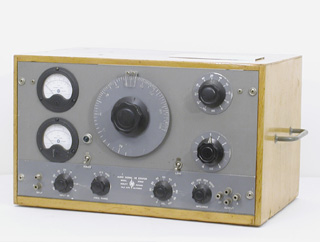 |
The HP 205AG
|
The 205AG brought the output level to 5 Watts into an external load of 50, 200, 500 or 5000 ohms with a distortion of less than 1 % from 20 cps to 20,000 cps.
Another innovation is that the 205AG integrates six basic instruments in the same box to make amplifier or network, loss / gain measurements.
As shown in the block diagram below the signal source is the model 200B basic circuitry followed by a 5 Watt (2 x 6L6 tubes), push-pull amplifier whose output is applied to the network under test through a 110 dB, 1 dB step attenuator and a line matching transformer. The control part of the 205AG integrates two vacuum tube voltmeters, one to measure the input and the second to measure the output of the device under test.
This is the first example of an HP product that provides answers to multiple problems found in production testing. Combining different tools in a single unit results in many advantages for instruments of this era where temperature drift and component aging were significant sources of measurement uncertainty.
| 205AG Block Diagram - Page 12 of the 19-A, 1948 catalog - Owned by the Memory Project |
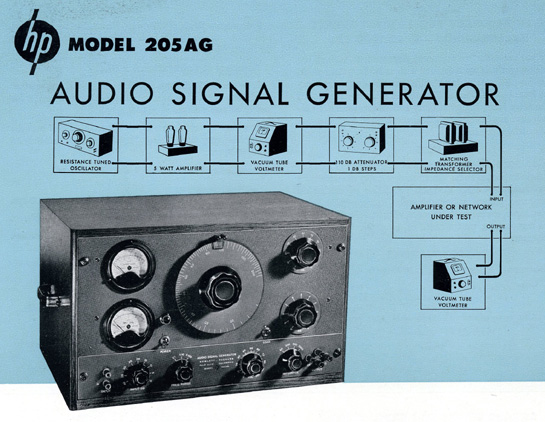 |
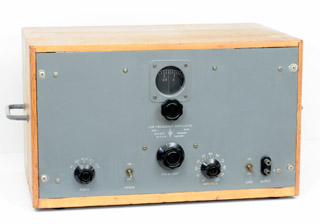 |
HP 202B |
The lowest-frequency HP oscillator using the RC, Wien-bridge tuning circuit concept of Bill Hewlett is the Model 202B which operates from 1/2 Hertz to 50 kHz, in four ranges.
To tune down to 0.5 Hertz, using a variable capacitor as the tuning element, requires a very large value for this capacitor in the oscillator circuit. This results in the very particular arrangement which is shown below. Four, 4 x 500 pf air variable capacitors are mounted behind the front panel and are mechanically connected to drive simultaneously with the tuning dial.
If you have never seen the inside of a 202B before, you might be a little disappointed when you open the cabinet for the first time. It looks like having had some problem during the transportation. But in spite of looks, it works well, the proof below. This strange design layout was imposed by the mechanical size of the variable capacitors which couldn't fit, in line, in the standard cabinet rack size.
| Gang of 4 x 4 x 500pf Variable Capacitors simultanously drive by the tuning dial in the HP 202B - View from the rear of the instrument |
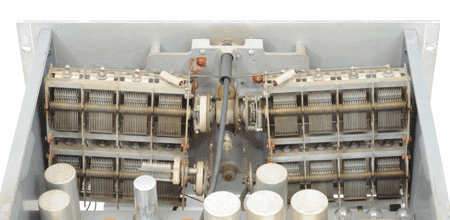 |
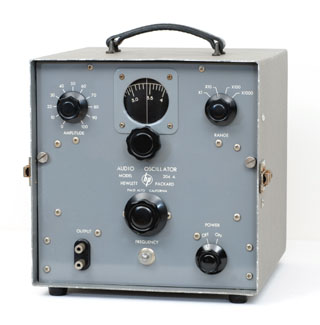 |
The HP 204A
|
No escape to the rule, the first portable battery-operated instrument produced by HP was an Audio Oscillator.
The HP 204A was introduced on page 13 of the 1950 catalog which is reproduced below for complete specification.
The circuitry is, one more time, the Bill Hewlett's classic resistance tuned oscillator with negative feedback made by a 3 Watt incandescent lamp. The main difference with the original 200A resides in the usage of low consumption vacuum tubes. Three miniature tubes are used: one 1U4 for the oscillator, and two 3V4 for the isolation and output amplifiers.
| HP204A - Page 13 of the 20-A, 1950 catalog - Owned by the Memory Project |
 |
| Inside View of the HP204A Owned by the Memory Project |
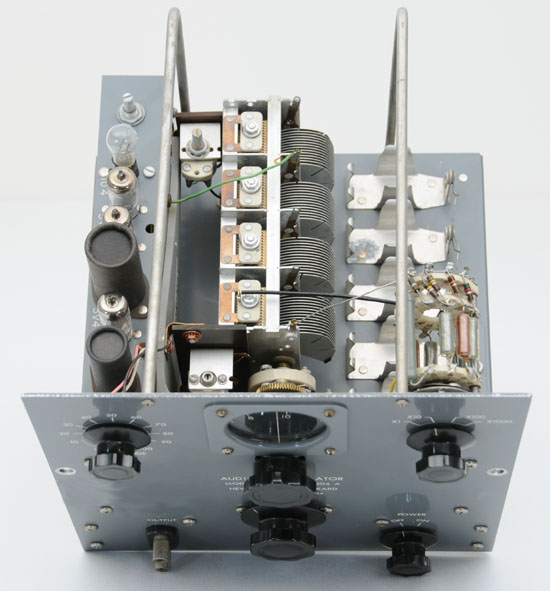 |
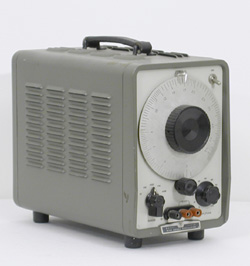 |
HP 200CD
|
In 1952 Barney Oliver did a complete redesign of Bill's basic oscillator to raise the upper frequency limit to 600 Kc.. Barney was a classmate of Bill and Dave at Stanford, and was employed by Bell Telephone Labs. He was recruited to join HP in the late 1940s.
John Minck, in his "Inside HP Narrative" tells the story as follows: "Barney had a way of looking at problems that was unique. His first look at the circuit of the HP 200 convinced him that simply by going to a balanced circuit configuration, he could get well-over a 10 to 1 improvement in the frequency coverage. They tried it, and it worked, to 600 Kc, the first of hundreds of contributions that Barney would make to this Company, over a 40 year career."
The HP 200CD has the following specifications in the 1952 catalog page 9: Frequency coverage 5 cps to 600 Kc in 5 ranges. 160 mW into 600 ohms or 20 Volts open circuit at 1 % distortion and +/- 1 dB frequency response.
The HP200CD was a serious competitor in the HP longest product life contest. It remained in the Hewlett-Packard Test and Measurement catalog until 1985, a full 33 years which is rare in the electronics industry. Last, but not least, the 200CD was the last fully vacuum tube instrument produced by HP. The 428B Clip-on DC Milliammeter remained one more year in the catalog but for the purist, the 428B included some transistors in its latest versions.
| Production line of the HP 200CD Oscillator Photo from the 1954, 15th Anniversary Issue of WATT'S CURRENT Courtesy of the Hewlett Packard company |
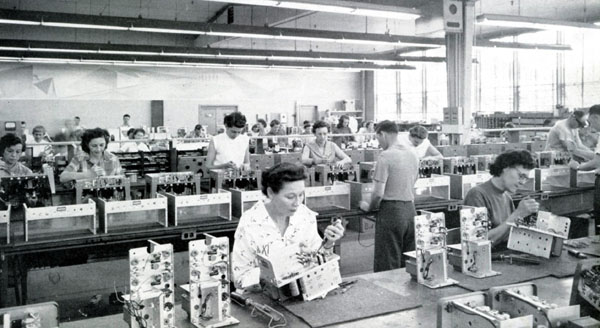 |